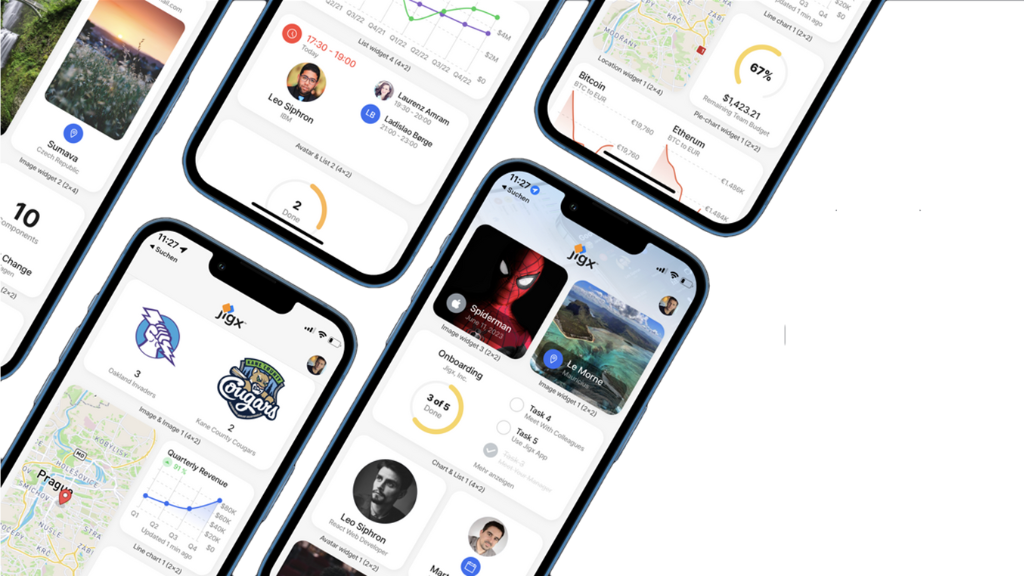Explore the evaluation of React Native alternatives, including Flutter, Xamarin, Ionic, native platforms, and Jigx, considering factors such as learning curve, developer experience, cost, popularity, community support, and ecosystem.
- Compare React Native alternatives: Flutter, Xamarin, Ionic, native platforms, and Jigx.
- Analyze criteria: learning curve, developer experience, cost, popularity, community, ecosystem.
- Evaluate strengths and weaknesses of each alternative.
- Consider project requirements, team expertise, and budget for optimal choice.
With the wide variety of smartphones and platforms available today, choosing the best framework and tools to create apps that work smoothly on different devices can be a challenge. While native apps provide the best performance and access to target devices’ hardware APIs, it also locks them down to a single platform. To avoid this, many developers prefer cross-platform frameworks like React Native, which was developed by Facebook.
While React Native has gained widespread popularity for its ability to build mobile apps using a single codebase for both iOS and Android, it has limitations like performance issues and challenges in integrating complex native modules that prompt developers to explore alternatives. This article explores some of the common React Native alternatives, considering various factors that impact the development process. The alternatives will be evaluated based on factors such as the learning curve, developer experience, cost, popularity, community and ecosystem support, and the quality of documentation and support.
Flutter
Flutter, developed by Google, has emerged as a strong contender in the cross-platform app-development industry. Its unique approach to compiling code ahead of time (AOT) has set it apart from other frameworks, offering several advantages and disadvantages. Like most frameworks on this list, Flutter offers comprehensive documentation to help you get started with building cross-platform apps with it.
**Learning curve: Flutter’s learning curve can be steeper than most frameworks on this list. This is because Flutter uses the Dart programming language, which is not as widely used as other programming languages, like JavaScript or Swift. This also makes Flutter a very complicated framework for beginners.
**Developer experience: Flutter’s developer experience is generally positive, with features that enhance code reuse, modularity, and overall development. Hot reload allows developers to see changes reflected instantly in the app, speeding up development cycles. The framework’s widget-based approach promotes modularity and code reuse, making it easier to maintain large codebases. However, it’s important to note that Flutter apps tend to be larger than apps developed with other frameworks in general. Also, Flutter offers limited access to native device APIs. So if you are looking to build an app that utilizes a lot of native APIs, you might be better off with native development.
**Cost and popularity: Flutter is an open source framework, so it’s free to use and modify, which has contributed to its growing popularity among developers. Flutter’s popularity is also fueled by its association with Google, which provides ongoing support and updates for the framework. However, due to its complexity, it is not as popular as some of the other alternatives on this list. This can become a slight problem for you if you are looking to hire new Flutter developers or find more opportunities as a Flutter developer yourself.
**Community and ecosystem of packages: Compared to other frameworks, Flutter has garnered a large number of learners in the Stack Overflow 2023 Developer Survey, indicating that its community is growing at a faster rate than other frameworks. The framework also boasts a growing ecosystem of third-party packages, providing developers with ready-to-use components and libraries.
A unique aspect of Flutter is its use of the Skia rendering engine, which draws UI elements directly on the device’s graphics hardware. This approach bypasses the need for a JavaScript bridge, resulting in native-like performance and a smooth user experience. However, it also means that developers must learn Dart, which may be a barrier for some.
To sum up, Flutter is a great React Native alternative for developers seeking a framework with native-like performance and a modern development experience. While its learning curve may be steeper and there are issues with app size being too large and native API access being limited, the framework’s growing community and extensive package ecosystem make it a viable choice for cross-platform mobile app development.
Xamarin
Xamarin, acquired by Microsoft in 2016, is a popular cross-platform mobile app development framework that utilizes C# and the .NET ecosystem. It offers a unique approach to cross-platform development by providing native-like performance and a familiar development environment for .NET developers. Similar to most frameworks on this list, Xamarin offers extensive, well-written documentation. Additionally, Microsoft provides dedicated support for Xamarin developers, offering assistance through forums, mailing lists, and issue trackers.
**Learning curve: While Xamarin has a rather steep learning curve for absolute beginners compared to other frameworks, it can be quite simple for developers with a background in C# and .NET. While C# is a widely used language, developers may need to familiarize themselves with Xamarin-specific concepts and APIs. However, the framework offers detailed documentation, and there are extensive online resources that can help you quickly get started.
**Developer experience: Xamarin provides a positive developer experience, particularly for .NET developers who appreciate the familiarity of the C# language and the .NET ecosystem. The framework’s code-sharing capabilities enable developers to reuse code across platforms, promoting code modularity and efficiency. Additionally, Xamarin’s integration with Visual Studio provides a robust development environment with advanced debugging and profiling tools. However, it is important to understand that the development time for Xamarin is longer than the other options due to its coding style. Xamarin tools tend to take longer to update than the native development tools for iOS and Android. Also, Xamarin apps are typically larger in size than native apps.
**Cost and popularity: Xamarin is another open source framework and has fostered a vibrant community of developers, contributing to its growing popularity. Xamarin’s popularity is further enhanced by its strong integration with the .NET ecosystem, attracting developers who are already invested in that technology stack.
Community and ecosystem of packages: While Xamarin boasts a large and active community of developers, the growth in its popularity has been slow in the last few years. Xamarin also does not have as many third-party libraries as some other cross-platform frameworks. This may require you to write more code from scratch when developing Xamarin apps.
Xamarin enables developers to share code across different platforms. Developers can write a significant portion of their code in C#, which is then compiled into native code for each target platform (Android and iOS). This approach enables developers to leverage their .NET expertise and maintain a single codebase for multiple platforms.
To sum up, Xamarin is a versatile cross-platform framework, particularly for .NET developers seeking to expand their skills in mobile app development. Its native-like performance, code-sharing capabilities, and integration with the .NET ecosystem make it a compelling choice for enterprise applications and large-scale projects. However, its steep learning curve and comparatively limited popularity (and community support) may be a problem for beginner developers.
Ionic
Ionic, developed by Ionic Framework, is a cross-platform mobile app development framework that utilizes web technologies such as HTML, CSS, and JavaScript. This approach offers a familiar development environment for web developers, making it an accessible choice for building cross-platform mobile apps.
Like all the frameworks on this list, Ionic’s official documentation is comprehensive and well maintained, covering all aspects of the framework, from basic concepts to advanced topics. You can seek support from Ionic’s community through forums, chat rooms, and issue trackers.
**Learning curve: Ionic’s learning curve is relatively gentle, especially for developers familiar with web technologies. The framework leverages existing web development concepts and provides a straightforward development process, making it easier for web developers to transition to mobile app development. However, for developers without web development experience, the learning curve may be steeper as they’ll need to grasp the fundamentals of HTML, CSS, and JavaScript.
**Developer experience: Ionic offers a positive developer experience, particularly for web developers. The framework provides a comprehensive set of tools and libraries, enabling code reuse, modularity, and efficient development practices. Additionally, Ionic’s integration with popular development tools like Visual Studio Code and WebStorm provides a seamless and productive development environment. However, Ionic offers very limited access to native device APIs, and apps built in Ionic are typically very slow compared to native apps, especially on older devices. Ionic apps are essentially web apps, so they can be more complex to debug than native apps.
**Cost and popularity: Ionic is an open source framework, making it free to use and modify. This cost-effectiveness has contributed to its growing popularity among developers. Ionic’s popularity is also fueled by its large community of developers and its extensive ecosystem of third-party plugins.
**Community and ecosystem of packages: Ionic has an active and supportive community of developers, with a wealth of online resources, including tutorials, forums, and documentation. The framework also benefits from a vast ecosystem of third-party plugins, providing developers with ready-to-use components and libraries. However, Ionic’s popularity has been declining in the past few years.
Ionic’s unique feature is its web-based approach to mobile app development. Developers can utilize their HTML, CSS, and JavaScript skills to build native-looking apps, eliminating the need to learn platform-specific languages like Swift or Java. This approach can be particularly appealing to web developers seeking to expand their skills to mobile app development without a significant learning curve.
Both Ionic and React Native offer a familiar development environment for web developers. Ionic relies on a web-based rendering engine, while React Native utilizes a native rendering engine. This difference can influence the apps’ performance and overall user experience.
Native Platforms
Native platforms (such as Android and iOS) represent the conventional approach to mobile app development, utilizing the respective platform’s programming languages and tools to create apps that are specifically designed for each operating system.
While cross-platform frameworks offer their own advantages, native platforms remain a strong choice for developers seeking the best performance, control, and user experience. Just like all alternatives on this list, native platforms also offer quality documentation and support. Additionally, the platform vendors provide dedicated support through forums, mailing lists, and issue trackers.
**Learning curve: For developers with experience in Java or Kotlin for Android development and Swift or Objective-C for iOS development, the learning curve for native platforms is relatively gentle. They can leverage their existing knowledge of programming languages and development tools to create native apps. However, for developers without prior experience in these languages or environments, the learning curve can be steeper, requiring a significant investment of time and effort.
**Developer experience: Native platforms provide developers with complete control over the app’s functionality, performance, and user interface. You get access to complete native UI kits and all hardware APIs without any abstraction layer. The development tools and SDKs are well established and provide extensive documentation and support. Additionally, the native-development approach allows developers to take full advantage of the specific features and capabilities of each platform. The only issue here is that you cannot build cross-platform apps at all. You need to learn the native framework for each platform, which can require double the effort, if not more.
**Cost and popularity: Although native app development may require a higher initial investment due to the need for platform-specific development teams, it can often be more cost-effective in the long run, especially for complex or performance-critical applications. Native apps offer the best performance and direct access to device APIs, freeing you from the hassle of setting up bridges or looking for third-party packages that may help improve performance or access hardware APIs. Native apps also tend to perform better and offer a more consistent user experience across different devices, which can improve user satisfaction and reduce the need for ongoing maintenance and support.
**Community and ecosystem of packages: Native platforms benefit from large and active communities of developers, with extensive online resources, forums, and documentation. Additionally, there are vast ecosystems of third-party libraries and components available for both Android and iOS, providing developers with ready-made solutions for common development tasks.
The unique advantage of native platforms is their ability to deliver native-level performance and leverage platform-specific optimizations. This means that native apps can take full advantage of the device’s hardware and software capabilities, resulting in smoother animations, faster response times, and a more immersive user experience.
While React Native offers cross-platform compatibility and a faster development cycle, native platforms often provide superior performance, a closer-to-metal development experience, and more granular control over the app’s functionality. However, as building on native platforms is typically a slower process, limited to shipping on one platform at a time, it’s not ideal if your project needs rapid prototyping and a faster time to market. If your goal is rapid development and the ability to ship to multiple platforms from a single codebase, you may find the next alternative to be the best solution.
Jigx
Jigx is a mobile app development platform that allows businesses to build native iOS and Android apps with just SQL and JavaScript. Jigx is designed to be easy to use, even for developers with no prior experience in mobile app development.
Some of the key features offered by Jigx include the following:
**No special skills required: Jigx uses a declarative UI approach, which means that developers describe the desired UI state and Jigx takes care of rendering it. This makes development quite faster and easier. You can build native iOS and Android apps with familiar frameworks and languages. What takes ten weeks to build in a framework like React Native takes one week to build in Jigx using JavaScript, YAML, and SQL.
**Highly performant apps: Jigx apps are rendered using native UI components, which means that they can look and feel like native apps. Jigx apps work great in situations where things like offline access and real-time sync are vital. For instance, Jigx is used by LifeFlight crew to finalize mission information across the system in minutes, something that used to take half an hour.
**Minimal boilerplate needed: When developers build apps, they think of the top-tier features and how long that will take to build and work. Typically, these are features that make this app unique. There is a level of features underneath that often is not taken into account, such as OAuth integration, user sign-up and management, push notifications, deep linking, offline support, syncing data, REST continuation, binary file handling, behavior across platforms and devices, and more. There are libraries for React Native and Flutter for some of these things, but they still require a lot of code and QA. All of that adds to the cost and time of building an app. Jigx simplifies all of these tasks.
**Easy and fast: Jigx provides you with a running start and robust out-of-the-box functionality. From data access and syncing to UI and app store publishing, Jigx has you covered across all steps of the app life span (build, publish, manage, update). Additionally, Jigx helps you speed up your reaction to customers’ changing needs, optimize the cost of QA and release management, and improve your release frequency.
**Usability: Jigx allows you to focus on your backend, data, and features rather than the UI or user experience. The experience is similar to having a UI/UX designer in every builder’s pocket.
**Flexible app architecture: You can host multiple use cases (or mini apps) in one Jigx app. Jigx allows you to quickly add or update mini apps as business needs change. This adds to the flexibility of your business processes.
Companies all over the world use Jigx to create solutions like conference apps, student companion apps, hotel management apps, and more. You can learn more about these on the Jigx website.
Conclusion
While React Native emerged as a groundbreaking technology a few years back, issues such as below-average performance, difficulty in integrating complex native modules, complex debugging experience, and so forth have made many businesses look for alternatives to this Facebook-backed framework.
In such cases, the choice of the ideal cross-platform framework depends on the specific needs and priorities of each project.
For projects that prioritize rapid development and a native-like user experience, Flutter is a good option. If code reuse and integration with existing .NET codebases are paramount, Xamarin emerges as a compelling option.
For projects that prioritize a large community and extensive ecosystem of plugins, Ionic stands out. For projects that demand the highest level of performance and customization, native development platforms (Android and Swift) remain the preferred choice. Finally, Jigx offers a compelling option for businesses seeking a rapid development approach with minimal code complexity. Its SQL-, YAML-, and JavaScript-based syntax simplifies the development process, making it accessible to developers with a diverse range of programming backgrounds.
All in all, the decision of which cross-platform framework to adopt should be made after carefully considering your project’s specific requirements, the development team’s expertise, and overall budget constraints. Each framework offers unique strengths and trade-offs, making it essential to evaluate them thoroughly against the project’s specific needs to ensure an optimal outcome.



